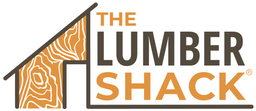Whether you are experienced in woodworking or not, you might have never come across a project requiring a live edge slab. If this is the case, we at The Lumber Shack have all of the information you need to process a live edge slab for your next project!
How To Process a Live Edge Slab – What Makes it Different?
Live edge slabs are a little bit different than the straight-edged lumber that most woodworkers are used to using for a few different reasons. The most obvious of which is that live edge wood still has the natural edges intact from where the bark used to grow. This one detail adds the additional complication of a variable width edge. While this is oftentimes desirable for a live edge project, many projects will require strict dimensions and that can be tough to find working with live edge wood. Not only that, but you’ll also want to put in extra care when finishing the live edges so that they don’t lose their natural beauty.
Another difference between live edge and traditional lumber is that live edge wood typically comes with more character than lumber. While this is usually a great feature of live edge wood, to process a live edge slab is more of a challenge since with great character comes artifacts like inclusions, knots, and voids. If you are interested in learning some great tips and tricks of the trade, keep reading to see the steps we take to keep our live edge slabs looking their best!
The 5 Steps in Processing Live Edge
Step One (Optional): Jointing and Gluing Up Your Live Edge Slab
This first step to process a live edge slab is optional depending on the wood you are working with. At The Lumber Shack, we have tons of bookmatched table top sets that need to be secured together to make up the full table top.
Jointing is a step that you don’t want to skip because it will help to make sure that the pieces of your tabletop live up perfectly without any gapping. In a large, established woodshop, jointing is usually done with a jointer, but there are several other techniques you can use to accomplish the same feat, such as a table saw or hand plane.
The glue-up stage goes hand-in-hand with jointing and should be done fairly soon after the boards have been joined so that your edges will sit flush against each other.

Step Two: Flattening Your Live Edge Slab
The second step to process a live edge slab is to flatten it based on your needs. For some applications – like a desktop or countertops – you will want a perfectly level slab, but for other projects – say a decorative mantel or shelf – you may not need the entire slab to be level. You will want to determine the needs of your project before getting started to avoid taking any unnecessary steps along the way. It is important to do this step after you join and glue the slabs together so that you can ensure they are all the same thickness.
In our shop, we use a CNC to flatten our slabs. The CNC is a great way to ensure you are getting not only a fully flattened slab, but also that you are getting the slab to the exact thickness you need if that is a factor for your project. Other tools that you can use to process a live edge slab include a drum sander or a planer.
Step Three: Preparing Your Slab for A Finish
The third step to process a live edge slab is to prepare it for an applied finish. This stage consists mostly of everyone’s favorite woodworking task: sanding! To sand a live edge slab is much the same as sanding a lumber board, but you have to consider the live edge itself. Since this is the part of the slab that some would argue is the most important, it is vital that certain actions are taken to keep its integrity. These steps include making sure that there is little to no dirt and debris and potentially removing any loose bark that might remain after the slab was dried.
Besides generally sanding the surface as you would any other piece of wood, another step in the preparation for a finish is to remove any loose parts from the inclusions, voids, and cracking that could be part of your slab. Taking the time to do this now will spare you from having to refinish sooner.

Step Four: Applying a Finish to Your Slab
Our fourth and most satisfying step to process a live edge slab is to apply your finish of choice. This is fairly consistent with what is recommended when using traditional lumber in woodworking, except you will want to make certain that you have applied an even layer on all of the nooks and crannies on the live edge. In our shop, we use either a spray-on satin lacquer or Rubio Monocoat to finish our live edge pieces.
Only Use Live Edge Slabs in Temperature and Humidity Controlled Areas
Storing or using live edge wood in a setting that is not temperature or humidity controlled can cause unexpected warping of your finished table top. Examples of spaces like this could be a basic storage unit or a traditional log cabin setting.
Step Five: Admire!
The last step to process a live edge slab is to sit back and admire the hard work that went into it. Live edge furniture is a labor of love and it truly shows in every finished piece. Now is a great time to take a few photos and tag us in the results!


